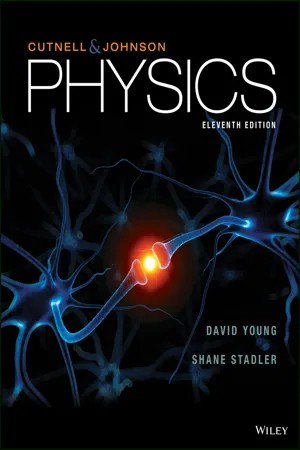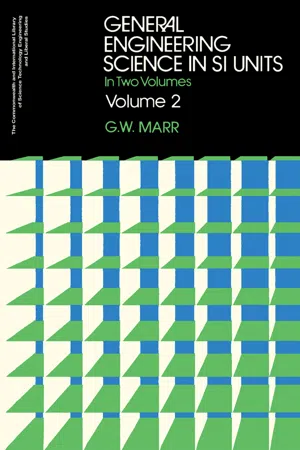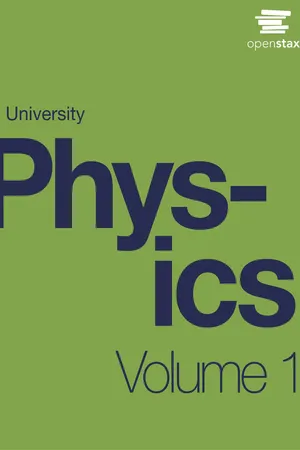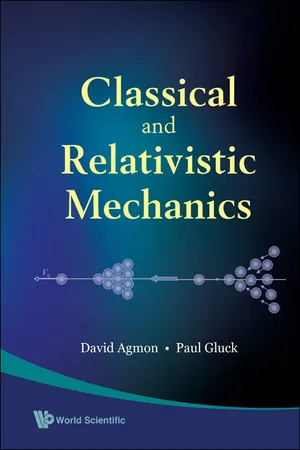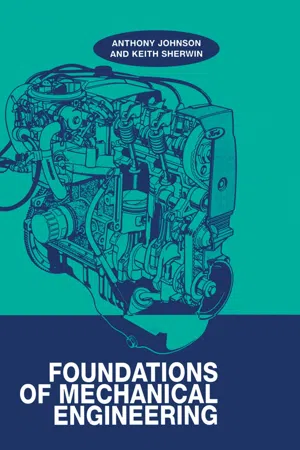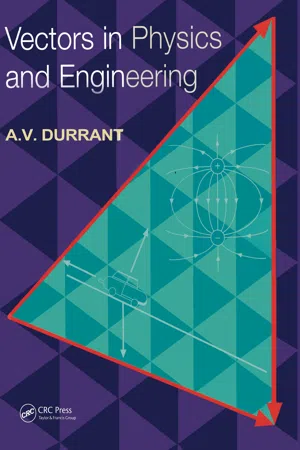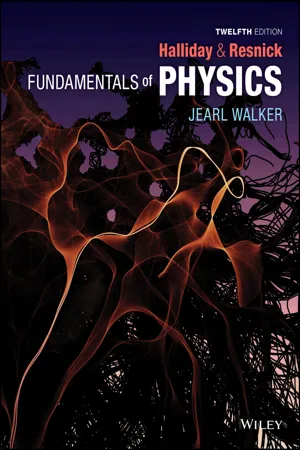Physics
Average Velocity and Acceleration
Average velocity is the displacement of an object over a specific time interval, while average acceleration is the change in velocity over the same time interval. Velocity is a vector quantity, meaning it has both magnitude and direction, while acceleration measures the rate of change of velocity. Both are important concepts in understanding the motion of objects in physics.
Written by Perlego with AI-assistance
Related key terms
1 of 5
12 Key excerpts on "Average Velocity and Acceleration"
- eBook - PDF
- Michael Tammaro(Author)
- 2019(Publication Date)
- Wiley(Publisher)
Hence- forth, when we refer to an object’s velocity, we mean its instantaneous velocity, with the magnitude of the instantaneous velocity being the object’s (instantaneous) speed. 2.4 Solve problems involving average acceleration, velocity, and time. 2.4.1 Interpret or determine the direction of the acceleration. If your friend tells you that her velocity has changed, what she probably means is that the magnitude of her velocity has increased or decreased; that is, the speed with which she is moving has changed. Your friend may use the word acceleration or deceleration when speaking about her changing speed. These words have very specific meanings in physics and, like velocity, the way they are used in everyday conversation is sometimes inconsist- ent with their scientific definitions. When an object’s velocity changes, we say that there is acceleration. Suppose that the velocity changes from v 0 to v in a time t t t 0 ∆ = − . We define the object’s average acceler- ation in the following way: a v t v v t t avg 0 0 = ∆ ∆ = − − (2.4.1) The SI unit of acceleration is / m s 2 . Acceleration is a vector quantity, so it has a magni- tude and a direction, with the direction of the acceleration being the same as the direction of the change in velocity. There is acceleration if there is a change in the direction of the velocity, in the magnitude of the velocity (i.e., the speed), or in both. To illustrate the use of Equation 2.4.1, consider the situation depicted in Animated Figure 2.4.1. A rocket, moving in the positive x direction, is coasting in space at a speed 2.4 ACCELERATION Learning Objectives Animated Figure 2.4.1 A rocket fires its forward thrusters and its speed increases. I N T E R A C T I V E F E A T U R E I N T E R A C T I V E F E A T U R E Acceleration | 51 A car is traveling at a speed of 21.8 m/s. The driver taps the brakes for 3.2 s during which time the magnitude of the average acceleration is 1.5 m/s 2 . - eBook - ePub
- John D. Cutnell, Kenneth W. Johnson, David Young, Shane Stadler(Authors)
- 2018(Publication Date)
- Wiley(Publisher)
change in the velocity is combined with the time during which the change occurs.As this sprinter explodes out of the starting block, his velocity is changing, which means that he is accelerating.PHOTO 2.1The meaning of average acceleration can be illustrated by considering a plane during takeoff. Figure 2.4 focuses attention on how the plane's velocity changes along the runway. During an elapsed time intervalΔt = t − t0, the velocity changes from an initial value ofto a final velocity ofv →0v →. The changeΔin the plane's velocity is its final velocity minus its initial velocity, so thatv →Δ. The average accelerationv →=v →−v →0is defined in the following manner, to provide a measure of how much the velocity changes per unit of elapsed time.a →‾During takeoff, the plane accelerates from an initial velocityFigure 2.4to a final velocityv →0v →during the time intervalΔt = t − t0.DEFINITION OF AVERAGE ACCELERATION
(2.4)SI Unit of Average Acceleration: meter per second squaredAverage acceleration =Change in velocity Elapsed time=a →‾=v →−v →0t −t 0Δv →Δ t(m/s2 )The average accelerationis a vector that points in the same direction asa →‾Δ, the change in the velocity. Following the usual custom, plus and minus signs indicate the two possible directions for the acceleration vector when the motion is along a straight line.v →We are often interested in an object's acceleration at a particular instant of time. The instantaneous accelerationa →can be defined by analogy with the procedure used in Section 2.2 - eBook - PDF
General Engineering Science in SI Units
The Commonwealth and International Library: Mechanical Engineering Division
- G. W. Marr, N. Hiller(Authors)
- 2013(Publication Date)
- Pergamon(Publisher)
Section 2 Velocity and Acceleration 2.1. Motion When the position of one body relative to another is continuously changing the bodies are said to be in relative motion. Motion, in fact, is always relative. In very many cases we are concerned with the motion of a body relative to the earth, and in such cases the word relative is generally omitted. We are accustomed to refer-ring simply to the motion of a motor vehicle or aircraft. We may say, for example, that a caj* is travelling at a speed of 30 km/h. When we do so, it must be understood that the speed is relative to the earth. 2.2. Velocity The velocity of a body is the rate at which the body is changing its position. Because direction is involved, velocity is a vector quantity. The magnitude, or numerical value, of a velocity is called the speed. The average speed of a body during a given interval of time IS measured by the ratio total distance^raven.d in given time W h e n a body travels equal distances during equal intervals of time, what-ever the magnitude of the time interval, the body is said to travel with constant speed. A velocity may change because of change in speed, or in the direction of motion or because of a change v in both of these. 32 VELOCITY AND ACCELERATION When a body moves in such a way that its velocity does not change, it is said to move with constant, or uniform, velocity. Hence to move with uniform velocity, a body must travel at constant speed in a straight line. EXAMPLE. A vehicle travels a distance of 840 m in 30 sec. Express its average speed in km/h. Distance travelled = 840 m = 0-84 km. 30 s = ai 0-84 km Time interval = 30s = g§öö h = iiö-h .*. average speed — —j = 100-8 km/h. EXAMPLE. The straight-line distance between two towns, A and B, is 49 km. Town A is due north-west from B. The road distance between the towns is 56 km. A motorist leaves A at 13.20 h and arrives at B at 14.10 h. Calculate (a) his average speed; (b) his average velocity. - eBook - PDF
General Engineering Science in SI Units
In Two Volumes
- G. W. Marr, N. Hiller(Authors)
- 2016(Publication Date)
- Pergamon(Publisher)
Section 2 Velocity and Acceleration 2.1. Motion When the position of one body relative to another is continuously changing the bodies are said to be in relative motion. Motion, in fact, is always relative. In very many cases we are concerned with the motion of a body relative to the earth, and in such cases the word relative is generally omitted. We are accustomed to refer-ring simply to the motion of a motor vehicle or aircraft. We may say, for example, that a car is travelling at a speed of 30 km/h. When we do so, it must be understood that the speed is relative to the earth. 2.2. Velocity The velocity of a body is the rate at which the body is changing its position. Because direction is involved, velocity is a vector quantity. The magnitude, or numerical value, of a velocity is called the speed. The average speed of a body during a given interval of time is measured by the ratio total distance um^d m given time w h e n a body travels equal distances during equal intervals of time, what-ever the magnitude of the time interval, the body is said to travel with constant speed. A velocity may change because of change in speed, or in the direction of motion or because of a change in both of these. 32 VELOCITY AND ACCELERATION When a body moves in such a way that its velocity does not change, it is said to move with constant, or uniform, velocity. Hence to move with uniform velocity, a body must travel at constant speed in a straight line. EXAMPLE. A vehicle travels a distance of 840 m in 30 sec. Express its average speed in km/h. Distance travelled = 840 m = 0-84 km. Time interval = 3 0 s = a|ööh = 1 ^-h 0-84 km .·. average speed = —j I2Ö h = 100-8 km/h. EXAMPLE. The straight-line distance between two towns, A and B, is 49 km. Town A is due north-west from B. The road distance between the towns is 56 km. A motorist leaves A at 13.20 h and arrives at B at 14.10 h. Calculate (a) his average speed; (b) his average velocity. - eBook - PDF
- William Moebs, Samuel J. Ling, Jeff Sanny(Authors)
- 2016(Publication Date)
- Openstax(Publisher)
The greater the acceleration, the greater the change in velocity over a given time. Acceleration is widely seen in experimental physics. In linear particle accelerator experiments, for example, subatomic particles are accelerated to very high velocities in collision experiments, which tell us information about the structure of the subatomic world as well as the origin of the universe. In space, cosmic rays are subatomic particles that have been accelerated to very high energies in supernovas (exploding massive stars) and active galactic nuclei. It is important to understand the processes that accelerate cosmic rays because these rays contain highly penetrating radiation that can damage electronics flown on spacecraft, for example. Average Acceleration The formal definition of acceleration is consistent with these notions just described, but is more inclusive. Average Acceleration Average acceleration is the rate at which velocity changes: (3.8) a – = Δv Δt = v f − v 0 t f − t 0 , 116 Chapter 3 | Motion Along a Straight Line This OpenStax book is available for free at http://cnx.org/content/col12031/1.5 where a − is average acceleration, v is velocity, and t is time. (The bar over the a means average acceleration.) Because acceleration is velocity in meters divided by time in seconds, the SI units for acceleration are often abbreviated m/ s 2 —that is, meters per second squared or meters per second per second. This literally means by how many meters per second the velocity changes every second. Recall that velocity is a vector—it has both magnitude and direction—which means that a change in velocity can be a change in magnitude (or speed), but it can also be a change in direction. For example, if a runner traveling at 10 km/h due east slows to a stop, reverses direction, continues her run at 10 km/h due west, her velocity has changed as a result of the change in direction, although the magnitude of the velocity is the same in both directions. - eBook - ePub
Doing Physics with Scientific Notebook
A Problem Solving Approach
- Joseph Gallant(Author)
- 2012(Publication Date)
- Wiley(Publisher)
The average speed is the total distance traveled divided by the elapsed time.There is an important difference between the average speed and average velocity. The average speed is always positive and conveys no information about direction. The average velocity contains information about direction and can be positive, negative or zero. It tells us how fast the object moved and the direction of the motion.The instantaneous velocity tells us how fast the object is moving right now, at this instant. As the time interval in Eq. (2.2) gets smaller, the average velocity gives a better approximation to the instantaneous velocity. The instantaneous velocity is the average velocity calculated over a vanishingly small time interval. Of course, “vanishingly small” brings us dangerously close to calculus. However, as you will soon see, we can derive equations for the instantaneous velocity without using calculus.Acceleration
As an object moves, its velocity can change. The object’s average acceleration is the rate of change in its velocity(2.4)where Δv = v - v0 is the change in velocity and Δt is the finite time interval. For constant acceleration, the average and instantaneous acceleration are always the same. The SI unit for acceleration is the meter per second per second (m/ s2 ). The American unit for acceleration is the foot per second per second (ft/ s2 ), although the mile per hour per second (mi/ h/ s) is also used.Example 2.3A test driveWhat is the constant acceleration of a car that goes from zero to sixty in 4 seconds?Solution.The phrase “zero to sixty” refers to miles per hour, so you need to convert 60.0 miles per hour to meters per second. The following expression converts the final velocity with the Solve Method .You can use Eq. (2.4) and Evaluate - eBook - PDF
- David Halliday, Robert Resnick, Jearl Walker(Authors)
- 2020(Publication Date)
- Wiley(Publisher)
For motion along an axis, the average acceleration a avg over a time interval Δt is a avg = v 2 − v 1 t 2 − t 1 = Δv Δt , (2-7) where the particle has velocity v 1 at time t 1 and then velocity v 2 at time t 2 . The instantaneous acceleration (or simply acceleration) is a = dv dt . (2-8) In words, the acceleration of a particle at any instant is the rate at which its velocity is changing at that instant. Graphically, the acceleration at any point is the slope of the curve of v(t) at that point. We can combine Eq. 2-8 with Eq. 2-4 to write a = dv dt = d dt ( dx dt ) = d 2 x dt 2 . (2-9) In words, the acceleration of a particle at any instant is the second derivative of its position x(t) with respect to time. A common unit of acceleration is the meter per second per second: m/(s ⋅ s) or m/s 2 . Other units are in the form of length/(time ⋅ time) or length/time 2 . Accel- eration has both magnitude and direction (it is yet another vector quantity). Its algebraic sign represents its direction on an axis just as for displacement and velocity; that is, acceleration with a positive value is in the positive direction of an axis, and acceleration with a negative value is in the negative direction. Figure 2-6 gives plots of the position, velocity, and acceleration of an el- evator moving up a shaft. Compare the a(t) curve with the v(t) curve — each point on the a(t) curve shows the derivative (slope) of the v(t) curve at the corresponding time. When v is constant (at either 0 or 4 m/s), the derivative is zero and so also is the acceleration. When the cab first begins to move, the v(t) 2-3 ACCELERATION Learning Objectives After reading this module, you should be able to . . . 2.12 Given a graph of a particle’s velocity versus time, determine the instantaneous acceleration for any par- ticular time and the average acceleration between any two particular times. - eBook - PDF
- David Agmon, Paul Gluck;;;(Authors)
- 2009(Publication Date)
- WSPC(Publisher)
(e) Humans find it difficult to locate sounds originating from the so-called 'conical regions of uncertainty', both in front and behind them. When the source is directly behind or in front of us, our ears receive the sound signal simultaneously, making it difficult to locate the direction of the source. 2.4 Average and instantaneous acceleration In physics a body is considered to accelerate whenever its velocity changes with time, whether it is the magnitude of the velocity (increase or decrease) or the direction, or both, as illustrated in the diagrams. (In everyday speech acceleration is usually associated only with an increase in speed. Although 'deceleration' is used occasionally to describe a decrease in speed, we shall not employ this term). Since it rare for a body to sustain a constant velocity, most known scenarios will be accelerated motions. Increase in magnitude Decrease in magnitude Change in direction Change in both magnitude and direction Chapter 2 Kinematics 31 Acceleration is derived from velocity change much as velocity is derived from displacement change. Thus, average acceleration is defined by y _ y AT/ o ^ -^ -^ — (2.5) t 2 -t x At in which V { , V 2 are the velocities of the body at times t t t 2 , respectively. In like manner we define instantaneous acceleration as the time derivative of the velocity: r AV dV d 2 x „ ^ a = hm = = — - (2.6) A ^° At dt dt 2 From the defining formula we see that the acceleration vector is parallel to the direction of the velocity-change vector AV, rather than to the velocity itself (since division by the scalar A* does not influence direction). For example, if a stone is thrown vertically upward, the direction of its velocity is opposite to that of its acceleration. For a body thrown horizontally the acceleration is perpendicular to the direction of the initial velocity. Example 4 Kinematic formulae for constant acceleration. - eBook - ePub
- A. D. Johnson(Author)
- 2017(Publication Date)
- Routledge(Publisher)
Fig. 2.1 Displacement diagram.Figure 2.1 gives an example of a man who walks 3 km east then 4 km north. He has actually walked a distance of 7 km but has been displaced from his start point by only 5 km.2.2.2 Velocity
Velocity is the value of displacement measured over a period of time. It is the rate over which a distance/displacement is traversed. The magnitude of velocity is often expressed in convenient units such as kilometres per hour or miles per hour; however, these should be regarded as observation and comparison units. For analysis purposes velocity is better expressed in SI units of m/s.2.2.3 Average velocity
Consider a car travelling between two towns at an average velocity of 50 km/h. On the journey the car will have stopped at traffic lights, crawled in traffic queues and ‘speeded up’ on fast stretches of road. It would be difficult to record the variations in velocity throughout the journey but average velocity can be considered as follows:average velocity =saytotal distance total time takenThe average velocity ignores the variations in the actual velocity and gives a value which assumes the whole journey to have been undertaken at a constant velocity of 50 km/h.= 50km/h75 .km15hAn example of an average velocity calculation is when ‘lap time’ is recorded for a racing car completing laps on a racing circuit. The lap time is taken from the start of the lap to the completion of the lap and can then be used to calculate the average velocity using the known distance around the circuit.Constant velocity is a special value because it assumes that a body moves over equal distances in equal intervals of time. In terms of the car considered above, it would need to start instantly, move in a given direction at 50 km/h and continue at that velocity, without variation, until it reached its destination, where it would instantly stop.This situation is obviously not practical but for analysis it is sometimes useful to consider. Perhaps the closest physical situations are those where a near constant velocity has been reached and the time is measured over a particular distance. Typical examples include water or land speed record attempts where the distance is usually ‘the measured mile’. - eBook - ePub
- Alan Durrant(Author)
- 2019(Publication Date)
- CRC Press(Publisher)
Fig 3.11 ).Fig 3.11The parabolic path of a projectile. The displacement, velocity and acceleration vectors are shown at aninstant t .Summary of section 3.2- The derivative of a vector function f (f) is a vector function denoted by df /dr or f ′(f) and defined by Eq (3.14 ). The derivative is always tangential to the space curve of f and points in the direction of increasing i.
- The velocity is defined to be the derivative of the displacement, and the acceleration is defined to be the derivative of the velocity (Eqs (3.16 ) and (3.18 ).) The average velocity and average acceleration are given by Eqs (3.15 ) and (3.17 ).
Fig 3.12(a) The path of a diving aeroplane showing the velocity vectors at t = 0 s and t = 5 s . (b) The velocity vectors redrawn with a common beginning point Δv is the change in velocity in the 5 s interval.Example 2.1 (Objective 3 ) Fig 3.12a shows the curved path of an aircraft executing a dive in a vertical plane. The directions of the velocity vectors at t = 0 s and t = 5 s are also shown. Given that | v (0 s) | = | v (5 s) | = 150 ms−1 , determine the average acceleration of the aircraft during the 5 s interval.Solution 2.1 The average acceleration is=Δ vΔ tv( 5 s ) − v( 0 s )5 sThe velocity vectors are drawn in Fig 3.12b from a common beginning point C.The angle a is 180° – 2 x 50° = 80° and so the magnitude of Δv is| Δ v |= 2| v= 2( 0 s )| sin( α / 2 )( 150 m s) sin− 1( 40 ∘ ) = 192.8ms− 1The magnitude of the average acceleration is therefore (192.8 ms–1 )/5 s = 38.6 ms–2 . The direction of the average acceleration is the direction of Δv - eBook - PDF
- David Halliday, Robert Resnick, Jearl Walker(Authors)
- 2021(Publication Date)
- Wiley(Publisher)
Displacement If a particle moves so that its position vector changes from r → 1 to r → 2 , the particle’s displacement Δ r → is Δ r → = r → 2 − r → 1 . (4.1.2) The displacement can also be written as Δ r → = ( x 2 − x 1 ) ˆ i + ( y 2 − y 1 ) ˆ j + ( z 2 − z 1 )k ̂ (4.1.3) = Δx ˆ i + Δy ˆ j + Δz k ̂ . (4.1.4) Average Velocity and Instantaneous Velocity If a particle undergoes a displacement Δ r → in time interval Δt, its average velocity v → avg for that time interval is v → avg = Δ r → ____ Δt . (4.2.1) As ∆t in Eq. 4.2.1 is shrunk to 0, v → avg reaches a limit called either the velocity or the instantaneous velocity v → : v → = d r → ___ dt , (4.2.3) which can be rewritten in unit-vector notation as v → = v x ˆ i + v y ˆ j + v z k ̂ , (4.2.4) where v x = dx /dt, v y = dy/dt, and v z = dz /dt. The instantaneous velocity v → of a particle is always directed along the tangent to the particle’s path at the particle’s position. Average Acceleration and Instantaneous Accele- ration If a particle’s velocity changes from v → 1 to v → 2 in time interval ∆t, its average acceleration during ∆t is a → avg = v → 2 − v → 1 ________ Δt = Δ v → ____ Δt . (4.3.1) As ∆t in Eq. 4.3.1 is shrunk to 0, a → avg reaches a limiting value called either the acceleration or the instantaneous acceleration a → : a → = d v → ___ dt . (4.3.2) In unit-vector notation, a → = a x ˆ i + a y ˆ j + a z k ̂ , (4.3.3) where a x = dv x /dt, a y = dv y /dt, and a z = dv z /dt. Review & Summary Projectile Motion Projectile motion is the motion of a par- ticle that is launched with an initial velocity v → 0 . During its flight, the particle’s horizontal acceleration is zero and its vertical acceleration is the free-fall acceleration ‒g. - eBook - PDF
- John D. Cutnell, Kenneth W. Johnson, David Young, Shane Stadler(Authors)
- 2018(Publication Date)
- Wiley(Publisher)
However, all of the questions are available for assignment via WileyPLUS. Section 2.1 Displacement 1. What is the difference between distance and displacement? (a) Distance is a vector, while displacement is not a vector. (b) Displacement is a vector, while distance is not a vector. (c) There is no difference between the two concepts; they may be used interchangeably. Section 2.2 Speed and Velocity 3. A jogger runs along a straight and level road for a distance of 8.0 km and then runs back to her starting point. The time for this round-trip is 2.0 h. Which one of the following statements is true? (a) Her average speed is 8.0 km/h, but there is not enough information to determine her average velocity. (b) Her average speed is 8.0 km/h, and her average velocity is 8.0 km/h. (c) Her average speed is 8.0 km/h, and her average velocity is 0 km/h. Section 2.3 Acceleration 6. The velocity of a train is 80.0 km/h, due west. One and a half hours later its velocity is 65.0 km/h, due west. What is the train’s average acceleration? (a) 10.0 km/h 2 , due west (b) 43.3 km/h 2 , due west (c) 10.0 km/h 2 , due east (d) 43.3 km/h 2 , due east (e) 53.3 km/h 2 , due east. Section 2.4 Equations of Kinematics for Constant Acceleration 10. In which one of the following situations can the equations of kinematics not be used? (a) When the velocity changes from moment to moment, (b) when the velocity remains constant, (c) when the acceleration changes from moment to moment, (d) when the acceleration remains constant. 13. In a race two horses, Silver Bullet and Shotgun, start from rest and each maintains a constant acceleration. In the same elapsed time Silver Bullet runs 1.20 times farther than Shotgun.
Index pages curate the most relevant extracts from our library of academic textbooks. They’ve been created using an in-house natural language model (NLM), each adding context and meaning to key research topics.

